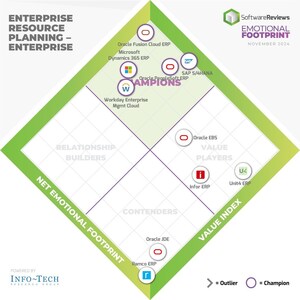Info-Tech's research shows that by addressing their unique cybersecurity challenges, government departments and agencies can improve their ability to attract and retain cybersecurity professionals, even with increased competition from the private sector.
TORONTO, May 30, 2023 /PRNewswire/ - Governments worldwide are becoming increasingly digital, leading to more prevalent and more diverse cyberattacks. These attacks impact governments, businesses, and individuals by compromising critical infrastructure; disrupting essential services, power, and communications systems; and leaving people without access to the resources they need. To help government security leaders take proactive steps to address these challenges and protect citizens from the potentially devastating digital and real-world impacts of a cyberattack, global IT research and advisory firm Info-Tech Research Group has published its new blueprint, Addressing the Cybersecurity Talent Shortage in Government.
This research-backed industry resource, designed to guide IT leaders and organizations in navigating specific challenges, explains that digital transformation and technologies have been integrated into all aspects of public sector operations, fundamentally changing the way services are delivered and how value is provided to citizens. This transformation also involves a cultural shift, as government departments and agencies must continually challenge traditional processes and adapt to new ways of working.
Info-Tech's research further highlights that digital transformation is creating new attack surfaces through the new technologies, systems, and processes it introduces within government departments and agencies, leading to the following obstacles:
- Expanded Digital Landscape and Cyberthreats – Digital transformation in government involves the integration of new technologies, systems, and processes that lead to increased exposure to cyberthreats such as malware, ransomware, and other forms of cybercrime.
- Cultivating a Cybersecurity-Aware Culture – New challenges make it essential for government departments and agencies to foster a culture of cybersecurity awareness within their workforce through providing regular training and promoting a shared responsibility to maintain digital security.
- Addressing the Cybersecurity Talent Gap – The growing complexity of cyberthreats necessitates a skilled cybersecurity workforce in government. However, a shortage of cybersecurity talent makes it challenging to effectively combat these threats and safeguard digital infrastructure.
- Enhancing Cyber Resilience and Security – To mitigate the risks of cyberthreats, government departments and agencies must prioritize the creation of robust cybersecurity strategies, invest in employee training, and collaborate with external parties to enhance their cyber defense capabilities.
The research further explains that attracting and retaining top talent is a significant challenge for government agencies for several reasons, including their limited ability to offer competitive salaries, career growth and development, autonomy, and flexibility. Candidates may also see their rigid bureaucratic processes as a drawback.
"Governments must take proactive measures to enhance their cyber resilience as they become more digital," says Paul Chernousov, research director at Info-Tech Research Group. "A common challenge is getting the entire organization on board with cybersecurity measures, resulting in an insufficient understanding of strategies and technology, as well as difficulty in maintaining a skilled and engaged workforce."
Info-Tech's research offers the following "three pillars for protection" approach that government departments and agencies can use to address the cybersecurity challenges caused by digital transformation:
- Create a Cybersecurity Culture – Every employee plays a crucial role in safeguarding the organization's digital assets. Fostering a culture of accountability and collaboration throughout the organization can create a shared responsibility for cybersecurity.
- Implement a Cybersecurity Workforce Development Strategy – A cybersecurity workforce development strategy ensures security, compliance, and efficiency. Governments should implement a comprehensive cyber workforce strategy that includes acquiring individuals with the necessary skills and expertise and investing in innovative training programs and educational partnerships.
- Harness Artificial Intelligence – Investing in advanced technologies such as AI and machine learning can help detect threats more quickly and accurately. They can even assist with recruitment.
Info-Tech's three pillars for protection approach will help government agencies define the skills gap in their cyber workforce and build a development plan that includes strategies that fully empower skilled employees to resist cyberthreats.
Download the Addressing the Cybersecurity Talent Shortage in Government blueprint to learn how government security teams can better attract and retain cybersecurity professionals to protect national security and reduce organizational risk.
For media inquiries on the topic or to get exclusive, timely commentary from Paul Chernousov, a public sector subject matter expert, please contact [email protected]
Info-Tech Research Group is one of the world's leading information technology research and advisory firms, proudly serving over 30,000 IT professionals. The company produces unbiased and highly relevant research to help CIOs and IT leaders make strategic, timely, and well-informed decisions. For 25 years, Info-Tech has partnered closely with IT teams to provide them with everything they need, from actionable tools to analyst guidance, ensuring they deliver measurable results for their organizations.
Media professionals can register for unrestricted access to research across IT, HR, and software and over 200 IT and industry analysts through the firm's Media Insiders program. To gain access, contact [email protected].
SOURCE Info-Tech Research Group

WANT YOUR COMPANY'S NEWS FEATURED ON PRNEWSWIRE.COM?
Newsrooms &
Influencers
Digital Media
Outlets
Journalists
Opted In






Share this article